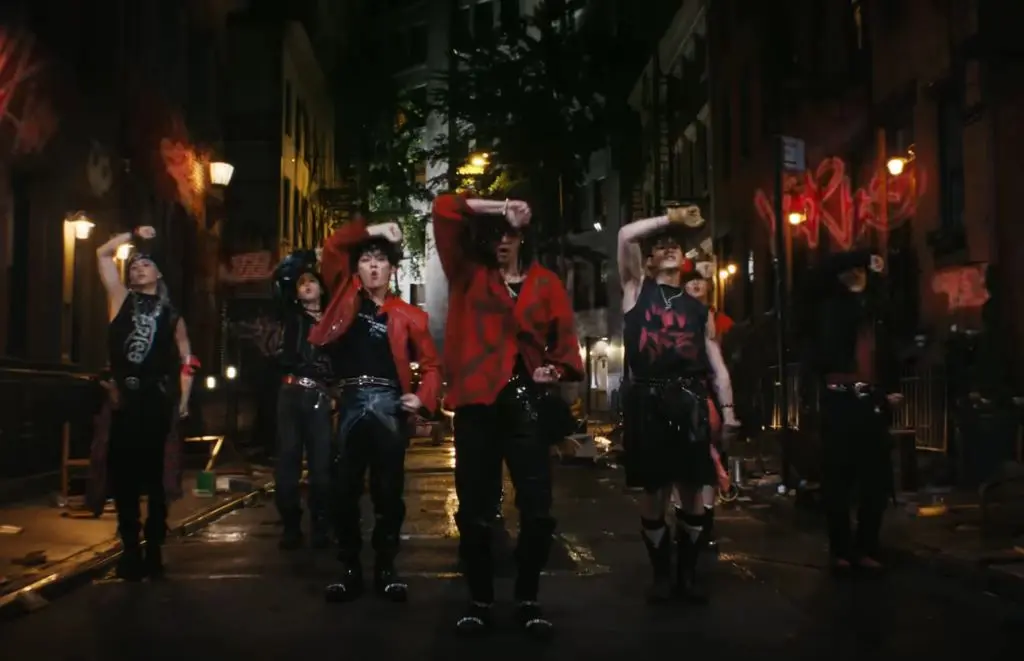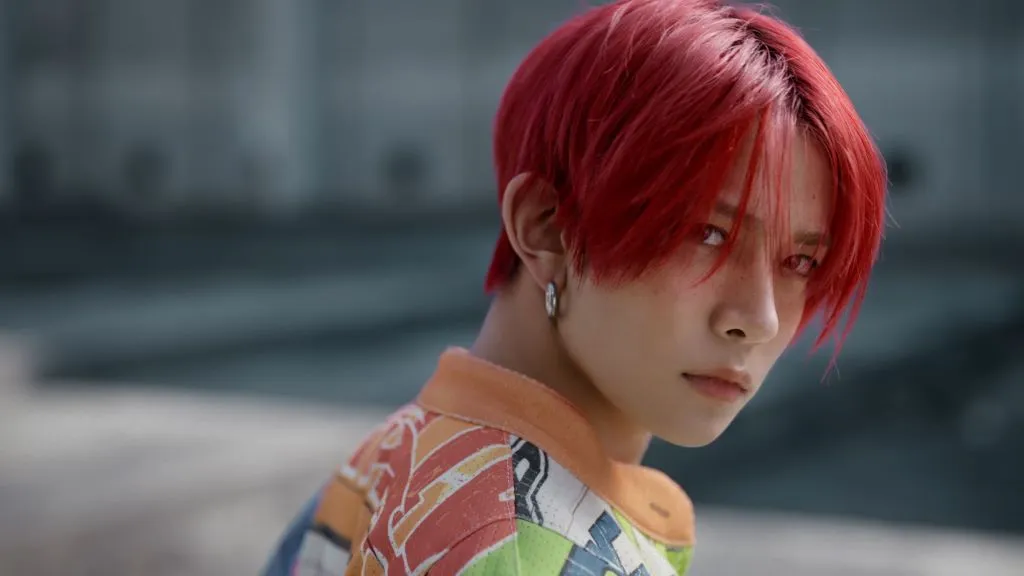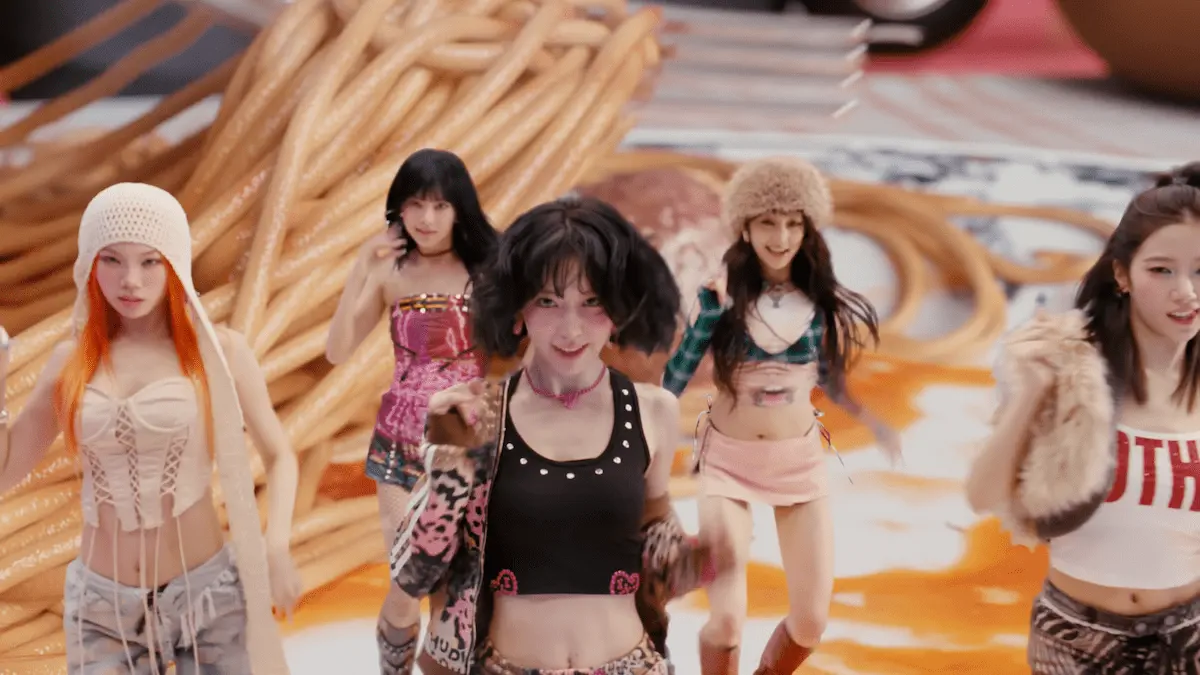Stray Kids 'Chk Chk Boom' MV Explained: The Movie They Made While Making History
Look, I know ‘Chk Chk Boom’ dropped over a year ago. But here’s the thing—I’m still finding new details every time I watch it. And after CEREMONY proved they’re operating on a completely different level, I wanted to go back and revisit the exact moment where this unshakeable confidence started.
Because ‘Chk Chk Boom’ wasn’t just a comeback. It was Stray Kids literally directing, producing, and starring in their own Hollywood blockbuster while the cameras rolled. Ryan Reynolds and Hugh Jackman showing up? That was the exclamation point on a statement they’d already made.
The comments section has been wild for over a year now—people still discovering the “kneel, I’m strong” wordplay, still losing their minds over Changbin’s flow at 1:52, still debating which movie genre worked best. So let me break down why this MV became the blueprint for everything that followed.

Source: Official JYP Entertainment YouTube (© JYP Entertainment)
Quick Navigation
- First Watch vs. Tenth Watch: What Clicked
- Credits & Chart Impact
- The Meta-Filmmaking Concept Nobody Expected
- The Wordplay That Went Viral
- Movie Genre Switches: A Timeline
- Why Ryan & Hugh Weren't Just a Cameo
- Performance Breakdown: The Standout Moments
- The Legacy: How This Changed Everything
- Q&A: Your Questions Answered
- Sources & Credits
First Watch vs. Tenth Watch: What Clicked
First time I watched this, my brain went: “Okay, cool action concept, Ryan Reynolds cameo is insane, the song slaps.”
Tenth time? I finally caught what they were actually doing.
At 0:03, Bang Chan’s holding a clapperboard. Not as a prop—as a director. The opening shot isn’t them walking onto a set. It’s them creating the set. Watch 0:08 closely: Changbin’s behind a camera, Lee Know’s checking the monitor, Hyunjin’s adjusting lighting. They’re not actors waiting for direction. They’re the entire film crew.
Then at 0:12, they snap into character and suddenly we’re in a Western. But here’s the genius part—throughout the entire MV, they keep cutting back to them making the movie. At 1:38, you see Felix operating a dolly cam while simultaneously being in the shot. At 2:15, I.N’s reviewing playback while the scene he just filmed is still happening.
This isn’t product placement for filmmaking. This is Stray Kids saying: “We write it, produce it, perform it, direct it. We are the auteurs of our own story.” In an industry where most groups are handed concepts by committees, this was their loudest declaration yet.
One commenter nailed it: “Stray Kids went from doing Deadpool’s themed performance to having the real Deadpool PLUS Wolverine in their music video.” But that progression wasn’t luck—it was strategy made visible.
Credits & Chart Impact
Artist: Stray Kids (스트레이 키즈)
Song: Chk Chk Boom (칙칙붐)
Album: ATE
Release: July 19, 2024
Agency: JYP Entertainment
Director: Bang Jae-yeob
Producers: 3RACHA (Bang Chan, Changbin, Han)
Featuring: Ryan Reynolds, Hugh Jackman
The Numbers That Matter:
- #49 on Billboard Hot 100 (JYP’s highest entry, breaking Wonder Girls’ 15-year record)
- #4 on Billboard Global Excl. US
- #1 on Billboard 200 (5th consecutive #1 debut—first group in history)
- #1 Trending Music Video in US, Australia, multiple countries
- 180M+ views (most-watched K-pop boy group MV of 2024)
- #1 on Genius Korea (July 2024, all genres)
Context: This wasn’t just promotional success. This was mainstream breakthrough. The song became the centerpiece of their record-breaking world tour and introduced Stray Kids to audiences who’d never heard K-pop before.
The Meta-Filmmaking Concept Nobody Expected
The MV’s structure is brilliantly layered. You’re watching:
- The “movie” they’re making (Western, heist, action sequences)
- Them making that movie (behind cameras, directing, reviewing shots)
- Them performing the song (choreography sequences)
- All three simultaneously
At 0:45, there’s this incredible moment where Seungmin’s in the middle of a choreographed move, but the camera pulls back to show Han filming him with a handheld camera. For a split second, you’re watching a performance, a behind-the-scenes documentary, and a music video all at once.
This meta approach does something clever: it makes the viewer complicit in the creation. You’re not just consuming content—you’re watching the content being made, which makes you feel like part of the process. That’s fan engagement design at its finest.
The Western scene at 0:28 is a perfect example. Classic standoff: tumbleweeds, desert backdrop, intense stares. But then 0:35 cuts to them adjusting the wind machine that’s creating the tumbleweed effect. The illusion is revealed, but it doesn’t break immersion—it deepens it. You’re impressed by both the scene AND the craft.
The Wordplay That Went Viral
Okay, the lyrical flex that had 1.9K people in the comments losing their minds:
“Pulling up I’m stun, rising up to the top like Neil A”
First listen, you think: “Cool, Neil Armstrong reference.”
But then the next line hits: “Kneel, I’m strong”
Wait. “Neil A” = “Kneel, I’m”?
BOOM. The entire line reconstructs itself:
- Surface level: Rising to the top like astronaut Neil Armstrong
- Hidden layer: “Kneel, I’m strong” = a dominance statement
- Full meaning: We’re reaching unprecedented heights (literally moon-level success), and our strength commands respect
One comment perfectly captured it: “I love how they play the word Neil Armstrong as ‘kneel, i’m strong’” This kind of bilingual wordplay is 3RACHA’s signature, but this might be their cleanest execution.
Other Lyrical Highlights
“Sick of this life, it’s regular” (Changbin at 1:52)
The way he delivers this right after Han’s low-register rap? The contrast in vocal tone makes “regular” sound like an insult. They’re not just successful—they’re bored with normal success. They need extraordinary.
“Chk Chk Boom” (the hook)
- “Chk Chk”: The mechanical sound of preparation—a camera shutter, a film reel loading, a gun cocking
- “Boom”: The explosive payoff, the impact, the moment of creation/destruction
The entire hook is an onomatopoeia for their creative process: prepare → execute → impact. It’s why the sound works across languages. You don’t need translation to understand the energy.
Movie Genre Switches: A Timeline
Let me map out every genre shift because the editing here is textbook:
0:00-0:27: Behind-the-Scenes / Meta Documentary
- They’re setting up, directing, preparing
- Establishes the “we’re making this” frame
0:28-0:44: Western / Standoff
- Desert setting, cowboy aesthetics
- Classic confrontation setup
- Tumbleweed at 0:31 is almost comedic in how on-the-nose it is
0:45-1:15: Heist / Action Thriller
- Slick suits, synchronized choreography
- “Planning the job” energy
- The group shot at 1:02 is straight out of Ocean’s Eleven
1:16-1:38: Gritty Urban Action
- Warehouse setting, raw lighting
- Hand-to-hand combat vibes
- This is their “we’re dangerous” section
1:39-2:05: Sci-Fi / Futuristic
- Neon accents, metallic surfaces
- The lighting shifts cooler
- Felix’s deep voice at 1:58 anchors this section perfectly
2:06-2:30: Back to Meta / Film Set
- Reviewing footage, adjusting shots
- The “we created all of this” reminder
2:31-3:10: Explosive Finale / All Genres Merged
- Rapid cuts between all previous genres
- Ryan and Hugh’s entrance at 2:45
- Final group shot at 3:05 with everyone in frame
The genius is that none of these switches feel jarring. The song’s structure supports every transition, and the “filmmaking” frame gives them permission to jump genres without losing narrative coherence.
Why Ryan & Hugh Weren’t Just a Cameo
When Ryan Reynolds and Hugh Jackman showed up at 2:45, the internet exploded. But this wasn’t celebrity for celebrity’s sake—it was strategic genius.
The Deadpool & Wolverine Connection
Stray Kids had already performed a Deadpool-themed stage. Having the actual actors from the movie appear in their MV did several things:
-
Legitimized them in Western entertainment spaces
Two Hollywood A-listers don’t show up in a K-pop video without respect for the artists -
Cross-promoted the Deadpool & Wolverine movie
Their song was on the soundtrack. This MV became unofficial promo for a Marvel film -
Proved their global reach
You don’t book Ryan Reynolds unless you’re a mainstream act -
Stayed on-brand
The cameo was comedic (Ryan asking “Can I be a member?” and getting “Nahhh”) which fit the playful, meta tone of the entire MV
One comment summed it up: “As Ryan said, even Marvel didn’t know they starred in SKZ MV shows how much close SKZ and Ryan is!”
The relationship was real, not transactional. That authenticity showed.
Performance Breakdown: The Standout Moments
Let me spotlight the individual moments that elevate this from “great MV” to “iconic”:
Changbin (1:45-2:00)
That entire second verse is a masterclass in rap delivery. The flow switches, the rhythmic pockets he finds, the way his voice cuts through the dense production—it’s technically flawless. Comment after comment mentions this part specifically: “Changbin’s rapping always gets me every single time.”
Watch 1:52 when he hits “sick of this life it’s regular”—the way he snaps that line with Han’s low register still echoing? That’s vocal layering as storytelling.
Han & Changbin Combo (1:16-1:45)
The low-to-high register contrast between Han and Changbin has always been their secret weapon, but here it’s weaponized perfectly. Han sets up with the growl, Changbin explodes with the rapid-fire delivery. It’s the musical equivalent of a one-two punch.
Felix (1:58 & 2:34)
His deep voice grounds every section it appears in. At 1:58, right before the chorus, his “Chk Chk Boom” acts as an anchor point—a moment of low-frequency stability before everything goes high-energy again. Then at 2:34, during the Ryan/Hugh section, he’s the one who introduces them, which is perfect casting—his voice has gravitas.
Hyunjin (0:52 & 2:18)
The swag is effortless. At 0:52, the way he moves during his line isn’t choreography—it’s character work. He’s embodying the Western gunslinger aesthetic. At 2:18, in the sci-fi section, he switches to sleek, fluid movements. That’s range.
Lee Know (Throughout)
His energy is kinetic. Watch 1:38—while everyone else is executing precise choreography, he’s adding texture with micro-movements. It’s the difference between performing steps and dancing.
Seungmin & I.N (Vocal Anchors)
The vocal line doesn’t get enough credit for the tonal stability they provide. Seungmin’s clarity at 0:40 and I.N’s control at 2:25 create breathing room in an otherwise dense track. Without their vocal technique, this would be exhausting to listen to.
Bang Chan (0:03 & 3:05)
Bookends the entire MV. Opening shot: he’s the director with the clapperboard. Final shot: he’s front and center with the whole crew. It’s visual storytelling that reinforces his role as the leader and creative visionary.
The Legacy: How This Changed Everything
Over a year later, ‘Chk Chk Boom’ is still the reference point. Here’s why it mattered:
1. It Proved the Concept
For years, Stray Kids insisted they were self-producing. This MV showed it. The meta-filmmaking wasn’t a gimmick—it was documentation. Every behind-the-camera shot reinforced: these guys actually do this.
2. It Bridged Markets
The song charted in Korea, the US, globally. It worked for K-pop stans and for casual listeners discovering them through Deadpool. That crossover appeal is rare and intentional.
3. It Set the Standard
CEREMONY, their next major comeback, had that same “we own this” confidence. But you can trace it directly back to ‘Chk Chk Boom’ establishing them as directors of their own narrative, not just participants.
4. It Created a Viral Moment
The wordplay, the cameos, the genre switches—this MV was designed for social media dissection. Every rewatch revealed new details. That’s engagement retention gold.
Comments like “I’m not even a stay but this was so good!” showed up constantly. That’s new fan acquisition through undeniable quality.
5. It Made History
First group ever to debut 5 consecutive albums at #1 on Billboard 200. That record was secured with the ATE album, anchored by this title track. The music video was the visual proof of why that achievement made sense.
Q&A: Your Questions Answered
What does "Chk Chk Boom" actually mean?
It's onomatopoeia representing their creative process. "Chk Chk" is the sound of preparation—a camera shutter, film loading, getting ready. "Boom" is the explosive impact when they execute. Together, it's their artistic philosophy: meticulous preparation followed by powerful delivery. It works across languages because the sounds are universal.
Why is the MV styled like a movie set?
It's a meta-commentary on their role as self-producing artists. By showing themselves as directors, cameramen, and actors simultaneously, they're making a statement: we don't just perform the content—we create it from concept to execution. It's the most literal visualization of "self-produced" ever put in a K-pop MV.
How did they get Ryan Reynolds and Hugh Jackman?
Stray Kids contributed a song to the Deadpool & Wolverine soundtrack and had already done a Deadpool-themed performance that Ryan noticed. The relationship was built on mutual respect—Ryan genuinely liked their work. The cameo was cross-promotional (helped the Marvel movie) but also authentic, which is why it landed so well.
What's the "Neil Armstrong" wordplay everyone's talking about?
"Rising up to the top like Neil A" sounds like a Neil Armstrong reference, but the next line reveals it: "Kneel, I'm strong." The wordplay works in English because "Neil A" phonetically becomes "Kneel, I'm"—so they're simultaneously referencing reaching the moon (unprecedented heights) and demanding respect (kneel before our strength). It's bilingual wordplay that 3RACHA's known for.
Why does this MV still feel fresh over a year later?
Layer density. There are so many visual and sonic details that each rewatch reveals something new. The genre switches, the background actions, the wordplay—it rewards attention. Plus, the meta-concept hasn't been replicated successfully by anyone else, so it still feels innovative. And honestly? The song just slaps. Good music doesn't expire.
How did this perform compared to their other releases?
This was their biggest mainstream breakthrough. #49 on Hot 100 (JYP's highest ever), #1 on Billboard 200 (5th consecutive, historic record), #1 trending in multiple countries, most-watched boy group MV of 2024. It performed better than previous releases because it successfully bridged their existing fanbase with new casual listeners, especially in Western markets.
🎬 Rewatch Mission: Count the Cameras
Here's a challenge I gave myself on watch #12: **How many times do you see a member operating a camera throughout the MV?**
I counted 7 distinct moments where they're actively filming (not just holding equipment as a prop). Can you find them all? Drop your count in the comments. Bonus points if you identify which member is behind each camera.
Hint: The most subtle one is at 2:03—blink and you'll miss it.
What Made You a STAY?
I’m genuinely curious—for those who discovered Stray Kids through this MV (and the comments show there were many), what was the specific moment that hooked you? Was it Changbin’s flow? The Ryan cameo? The sheer audacity of the concept?
And for long-time STAYs, where does ‘Chk Chk Boom’ rank in their discography for you? Because a year later, I’m still not sure if anything has topped it.
Sources & Credits
Primary Sources:
- Stray Kids “Chk Chk Boom” Official MV - YouTube
- Namu.wiki: Chk Chk Boom
- Billboard Chart Data (July-August 2024)
- Genius Korea Rankings (July 2024)
Chart Achievements:
- Billboard Hot 100: #49 (July 2024)
- Billboard Global Excl. US: #4
- Billboard 200: #1 (5th consecutive for group)
- YouTube: 180M+ views (as of October 2025)
- Genius Korea: #1 All Genres (July 2024)
Production Credits:
- Produced by: 3RACHA (Bang Chan, Changbin, Han)
- MV Director: Bang Jae-yeob
- Label: JYP Entertainment
- Album: ATE (2024)
Cultural Impact Notes:
- First JYP artist to chart this high on Hot 100
- Most-watched K-pop boy group MV of 2024
- Featured on Deadpool & Wolverine soundtrack
- Historic 5th consecutive Billboard 200 #1 debut




Comments